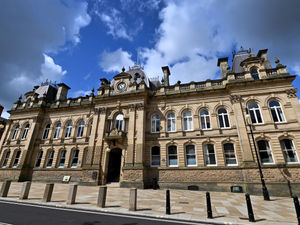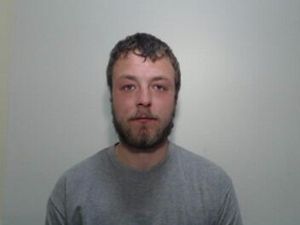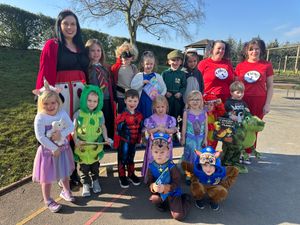Seven totally unique experiences you can only do in Wolverhampton
Wolverhampton has some unique attractions, but everywhere says that, so what can you do in our city that you can't do anywhere else?
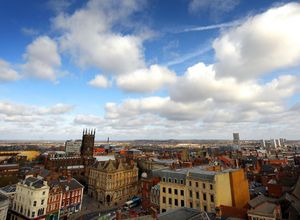
There are smells, sounds and sights you can only experience if you are standing right there, in Wolverhampton.
Take a tour with us, around Wolverhampton's unique experiences.
Marstons Brewery, home of Banks's, Chapel Ash
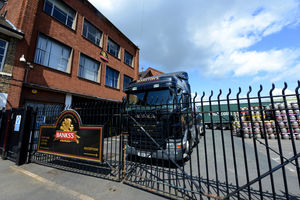
The Banks's brewery has been turning local ingredients into beer since 1875. And, it is easy to find as the road is even named the sprawling factory, Brewery Road, and if you have not got a map, or a phone then just look up at the biggest chimney in the sky and walk to the base. Now owned by multi-national Carlsberg-Marstons, the brewery is still brewing Banks's bitter, if you stand outside you can smell how the iconic tipple is made and the aroma it creates. Banks's kept on growing, taking over other breweries, and ended up being the third biggest in the UK.
The sprawling Victorian built brewery brings a tear to the eye of drinkers such is its beauty and because though technology has taken over ever facet of industry, in this building you can see, hear and smell how it has always been done. And if you have a few quid spare you can go on a guided tour of the brewery and see exactly why generations of Black Country drinkers order Banks's as soon as they get to the bar.
Graffiti and Modern Art collection, city centre

If all that talk of Banks's gives you a taste for seeing some of the best graffiti in the Midlands, then a short wander to Peel Street subway then you can see examples of the one of the finest artists of his generation - Temper, aka Aaron Bird.
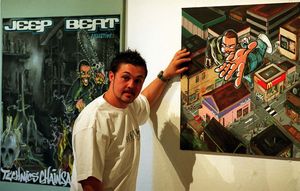
Unlike Banksy, with his private education and army of stencillers, Temper can spray paint Pre-Raphaelite style nudes free-hand with a can. His pictures adorn the walls of the rich and famous, and not so rich and famous, across the world. Unlike the free-wheeling days of yesteryear the multi-coloured wonderland of the Peel Street subway is all perfectly legal, after local artist Paul Pilgrim waited two years to get the go-ahead from Wolverhampton Council to let forty artists lose with their spray cans. Temper has gone down there under cover of darkness with his son to add his own brand of genius to the subway.
Temper along with Goldie helped make Wolverhampton one of the best places on the planet for graffiti in the 1980s. And if you want to see a glimpse of the metal-toothed polymath then his face adorns a new mural in Queen's Square. And if you stand with your back to the drum and base king's face and look right you can see another unique Wolverhampton art hotspot. Other cities have big old buildings full of masters, bought with slave profits and some even in galleries named after families and companies who made their blood money from the sugar plantations.
But in Wolverhampton, forget those fusky halls with paintings older than America, we have one of the best modern art collections in Britain. Wolverhampton Art Gallery, Lichfield Street, houses the The Contemporary Art Society collection of modern British artists with works by Tom Monnington and a surrealist picture by Thomas Lowinsky. Its Pop Art collection is outstanding Andy Warhol, Roy Lichtenstein, David Hockney and Peter Blake and his student singer Ian Drury. There is also remarkable selection of Northern Irish work, thanks to far-sighted gallery chiefs decided to build one of the best collections on earth of art representing The Troubles, with pieces from John Keane, Paul Graham, Jock McFadyen, Willie Doherty, Siobhán Hapaska and Anthony Davies.
The spot of the UK's first traffic lights, Princess Street
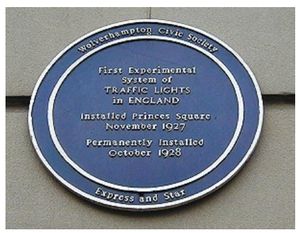
If you walk out the gallery and look diagonally left, you can see where another unique experience in Wolverhampton is, the spot where the first ever traffic lights in the country were installed.
In 1922 the technology was invented to automatically time traffic lights, before then police officers used to have to manually change the lights. Houston and New York were the first cities to buy traffic lights. In Britain, cars were becoming more popular but unfortunately accidents were also rising. Wolverhampton became the town to introduce automated traffic lights in 1927 in Princes Square at the junction of Lichfield Street and Princess Street on a trial basis.
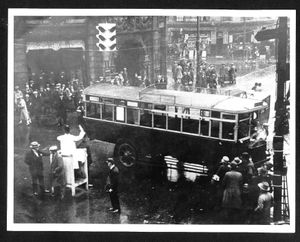
There is a blue historic plaque marking the spot where the first UK driver became an "amber gambler". If standing in a street imagining 1920s drivers first being amazed and then being frustrated at waiting at red light, then a similar high is out there. Leeds claim to have the first "permanent" traffic lights, which were unveiled on March 16, on the corner of Park Row and Bond Street.
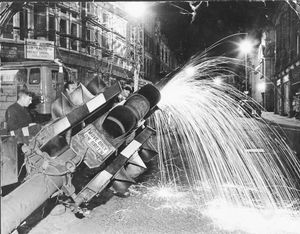
Which still makes them the second city to have traffic lights. Traffic light tourists standing in Princess Square will only have to travel 126.4 miles to see where the second set of lights were installed in Leeds.
Home of the orange chip, Bilston
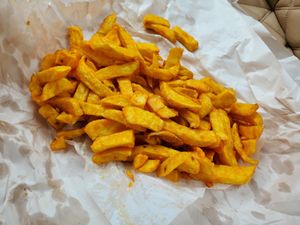
However, if trekking up North to see a second place set of traffic lights and that amber light is making you hungry, but you can't think why, then not far away in Bilston could be the answer.
Majors Chippy is the spiritual home of the orange chip, a Black Country delicacy which has filled a million column inches and added to the cholesterol count of generations of Black Country folk. Slap, bang, middle of Bilston, Majors is the chippy's lovers chippy. Customers can dine in, or takeaway. And they have been known to give away food to the less fortunate too.

The orange battered chip does not travel well, elsewhere in the country they frown on the double deep fat frying of chips, and even turn their nose up at E-number colourings, but not in Bilston. An overweight American food blogger made the pilgrimage to Majors recently, and gave it his thumbs up, probably because he was already out of breath to shout about it. But, the queues round the corner on a Friday at Majors shows the proof is in the pudding. And if an experience unique to Wolverhampton is what you want, then stand in that queue and chat to your fellow orange chippers, the conversation will be like no-other in the world.
The Trumpet, Bilston

Now Brummies and Black Country folk aren't ones to blow our own trumpet about where we live. Unlike the loud mouth Liverpudlian or Mancunian constantly banging how brilliant city is, whilst living in London, we pay the biggest compliment possible to our home towns, we still live there. Statistically, less people move away from where they were born than where we live. But, if you walk out of Majors, with your belly full and look down the road, you will see The Trumpet. A truly unique experience to Wolverhampton, live music keeps this place alive. Yes, it is small, but when jazz musicians turn up to play, it is like The Royal Albert Hall crammed into your nan's living room. This is where magic is made.
Live music magic, The Trumpet is where bands come to play to hone their live sets elsewhere, but every week the talent turns up, and so do the punters. There has been jazz being played at The Trumpet for more than 50 years, so they must be doing something right. Every year there is a Slade convention, and again, turn up to that, listen to the stories how Noddy and his mates conquered the music world despite their mad fringes, bonkers sideburns and flares so big you could fit ten Jackson Fives inside, and it will be an experience so unique you think "IT'S CHRISTMAS".
The Battle of Wodensfield, Wednesfield

Talking of long-haired unapologetically Alpha males, the Vikings came to a sticky end in Wolverhampton. The Battle of Wodensfield should be up there with the Battle of Hastings, especially as we won this battle. Go down to Hastings, and everything from the hospital to almost every pub references the biggest military loss in British history, but you will struggle to find a plaque let alone a visitors centre about the Battle of Wodensfield. Or The Battle of Tettenhall as its also known, but that is not to be confused with the recent protest about the alterations to Rock Junction. On August 5 910 a Viking army who had been taking liberties from Northumberland (which they colonised) to Bristol were defeated by a force led by one of our country's greatest women - Æthelflæd. Daughter of Alfred the Great and sister of Edward of Wessex, Æthelflæd and her Mercian and Saxon Army annihilated the Viking force, killing three Scandinavian kings on the battlefield - Ingwær, Eowils and Halfdan. Walk through Wednesfield market, down the canals, look down from the high ground and imagine our people actually getting one over on awful immigrants who invade our shores on boats, the type who raped and pillaged, not who claimed a few benefits because they are skint. And don't think this is ancient history, at the last Wolverhampton Council meeting, the Councillor for Wednesfield North Phil Bateman, in the spirit of the Viking fighters known as Beserkers who would go crazy on the battlefield, went beserk about a besmirching of his beloved Wednesfield. When being told to quieten down by his opposition. He bellowed: "It is a good job the Battle of Wodensfield was not held in 2024. There were a few a shouting matches were held then, and we sent the Vikings back with a flea in their ear. I will not be told to be quiet when it comes to Wednesfield. Am I being told I can not speak in my vernacular? My passion. I will not forget what the Government has snatched away from Wednesfield, just like we will not forget the Battle of Wednesfield." Watch Councillor Bateman evoking the 1,100 year old battle at council - at agenda item 8 https://wolverhampton.moderngov.co.uk/ieListDocuments.aspx?CId=129&MId=19928&Ver=4
Moseley Old Hall, Featherstone
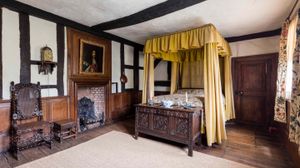
If Kings are your thing, especially English ones who escaped a brutal death in Wolverhampton, then a unique thing you can do in Wolverhampton is see where Charles II had his skin saved.
After losing the Battle of Worcester in 1651, Charles hotfooted it to Moseley Old Hall for safe haven from the Whitgreave family. He was being chased by Oliver Cromwell's troops and was right to fear for his life after the Roundhead general had instigated his father's execution two years previously.
You can walk through the same door as the relieved the King did, and see the bed he slept fully clothed in case he needed a sharp exit. Cromwell's soldiers did come calling and you can see where the six foot Royal was forced to hide to evade his enemy. He hid underneath the floor of a ‘frippery’ cupboard, where clothing and linen would be kept, and described it later in life as 'the best place he was ever in'. The King's letter to the woman who helped him escape to France is also on display at the Featherstone historic home.
Have we missed a unique Wolverhampton experience which you love to do? Email adam.smith@jpress.co.uk with your suggestions.

